|
|
Pastfinder
|
Name:
|
Pastfinder |
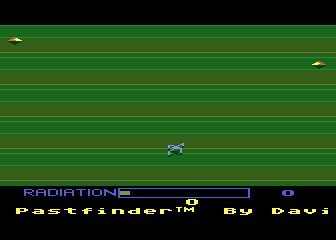 |
| Company: | Activision | |
|
Model #:
|
CC-104 | |
|
Programmer:
|
David Lubar | |
| Year: | 1984 | |
|
Released?
|
Yes
|
|
|
Notes:
|
Originally called
Explorer |
Guest Review by: Jonathan Rose
Activision released several stellar titles in 83 and 84 that
were heavily impacted by the great video game crash in 1983, so
much so that many of them barely got any market penetration
before being pulled from production. Of Activisionís
offerings, none are more obscure than Pastfinder.
Pastfinder (originally called Explorer) was programmed by Dave
Lubar, who also worked on Master of the Lamps and Hacker while
freelancing for Activision. These are highly regarded, top
of the line games, and Pastfinder is no different. Pastfinder
was released on disk and cartridge, and it was the last proper
Activision game to get a cartridge release on the Atari 8-bit
line.
In the game, you are the titular Pastfinder, a member of an
elite squad of time travelers who explore dangerous, radioactive
ruins in search of lost artifacts. Your ship, a fluidly-animated
spider-like craft, crawls and jumps myriads of different levels.
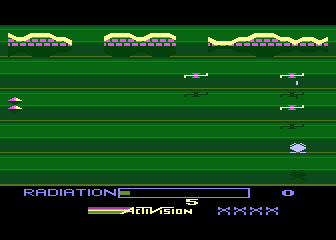
The game is organized around a central map grid of hundreds of levels, with each sector colored green, yellow or red, an indicator of that sectorís radiation level (colors differ slightly in the prototype). The radiation level is tracked via your Radiation meter, which increases at a steady rate, the speed being determined by the color of the zone you are in. Radiation acts as a timer, forcing you to move quickly before the meter fills up and destroys your ship.
Using the map indicator, you select the direction you want your timeship to go and select the target zone. You may also receive hints, via arrows, of the direction in which an extra life may lie, which often factors into your planning. Once you pick a zone, you are taken to the Supply screen.
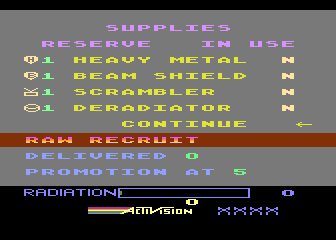
There are four main power-ups in the game. These are selected before entering a zone. The first three last indefinitely, until the time ship equipping them is destroyed. The last one is a one use item. Their functions are as follows:
| Heavy Metal |
Lowers the rate your ship accrues radiation |
| Beam Shield |
Protects you from the
enemy craft's laser attack |
|
Scrambler |
Prevents the enemy ship from tracking/seeing you |
| Deradiator |
Eliminates all accrued radiation and resets the
gauge |
All of these are important, but the Heavy Metal and Deradiator devices are critical for surviving high rad areas. The Beam Shield and Scrambler become critical later in the game, when the enemy ships become relentless.
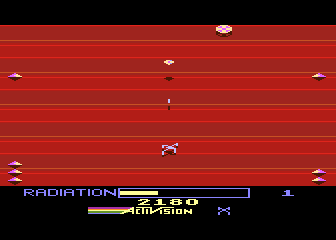
Once you select a zone, you enter the level proper. There are hundreds of these, and each of them are unique. They all consist of a vertically scrolling map (the scrolling speed is controllable by the playerís acceleration), and height in a key factor, as every item, enemy and obstacle has an elevation. Jumping changes the timeships elevation, and speed determines the length of time the ship spends elevated.
The levels themselves are chock full of walls (these come in all kinds of forms, and can have different elevations, tunnels, and moving sections etc.), stationary targets (these are either at ground level, or jump level), enemy ships (always ground level) artifacts, bases, forts and power-ups.
| Forts and Bases | You use these to score collected Artifacts |
| Stationary targets | These come in a dozen or so forms, and can be shot for points. Some are airborne, some are at ground level. |
| Artifacts | Circular disks that you collect to deposit at forts and bases, these are the main goal of the game, and what you are ranked on |
|
Time capsules |
Looking like a stack of wafers, these count as 5 artifacts |
| Power Ups | These credit you one each of Heavy Metal, Beam Shield, Scrambler, or Deradiator, depending on the type. |
| Enemy ship | This UFO looking craft randomly attacks from the top of the screen, homing in on your craft and firing lasers. |
| Crystals | A small, bouncing crystal that drops your rad meter by about a quarter when shot. These are critical to survival, and a lot of your strategy, particularly in red zones, revolves around shooting them. |
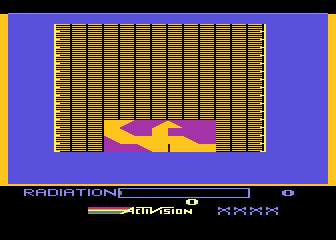
As you move through the level, you must constantly adjust your speed and height to avoid obstacles, and to get the right altitude to hit targets, while avoiding walls (high and/or low) and the random attacks of enemy craft. As you pick up artifacts and time capsules, your artifact counter goes up. Losing a life via radiation, collision, or getting shot will halve the number of carried artifacts, which can greatly affect your final rank (shown on the supply screen), which combined with the constant radiation time pressure, adds a nice risk/reward aspect to the gameplay
As you explore the zones, previously explored areas will show in black. Black zones increase radiation at the original zoneís level, but are empty of anything but walls. This can be deadly in red zones, as there will be no way of lowering radiation in level, so speeding through previously explored areas is a must (as is having a spare Deradiator or two on hand).
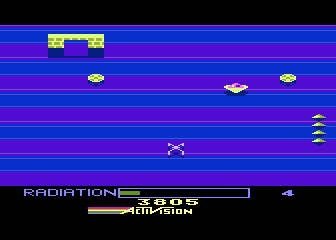
Eventually, after several missions bases (white ovals on the map, strange looking towers in the level) and forts (black squares on the map, a landing pad in level) will appear on the map. Once you make it to a sector containing one of these, you can pilot your ship to land on them, which will score all of the artifacts you currently carry, and eventually raise your ultimate rank, similar to the way Star Raiders works. This is independent from your point score.
Pastfinder is a brilliant game. Itís challenging, but has a fair and even difficulty progression. The animation and graphics are top notch for the era. Play control is incredibly tight, and makes piloting your timeship intuitive and fun. Deaths always feel fair, and the result of an actual mistake on your part. The light strategy elements and huge, non-linear map only add to the addiction factor, and the incredible number of different levels always draw you further into the game to explore new areas, even after many play-sessions. Pastfinder is the perfect swan song for Activisionís last efforts on the Atari 8-bit line.
Special thanks to Jonathan Rose for helping write this review.
| Version | Cart Text | Description |
| ?????? | Explorer | Different name |
